 Rusteikaitė, Ieva. On Materials Imitating Materials: Exploring Historical Decorated Papers. Semiotika, Vol. 18 (2023), 82–117. https://doi.org/10.15388/Semiotika.2023.3.
Rusteikaitė, Ieva. On Materials Imitating Materials: Exploring Historical Decorated Papers. Semiotika, Vol. 18 (2023), 82–117. https://doi.org/10.15388/Semiotika.2023.3.
ABSTRACT
Crossing the boundaries of any one discipline, the article provides an overview of research into historical decorated paper conducted by the author over the last several years. Examples of this seemingly very specific, ephemeral material, considered as an imitation of other materials, applied in bindings of printed books and manuscripts during the 18th and 19th centuries, are presented as anonymous artifacts of the past, strikingly characterised by their own materiality and thus involving also the researcher’s senses. Besides a historical overview of the main techniques of paper decoration in Europe, the place of this applied decorative element in the three-dimensional structure of the handmade book is also explored. The second part of the paper addresses the relevant problem of ornament as a plastic discourse, which has so far received less attention in semiotic research. Through a closer analysis of a several samples of decorated paper, questions about the semantic structure of the ornament and its effects are raised. Finally, when placed in the context of certain habits, needs and interests of eighteenth-century European society, decorated paper and its ornamental language emerge as a multilayered object with a culturally defined meaning.
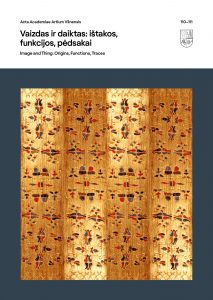 Rusteikaitė, Ieva. The Body and the Outfit of the Book: The Enigmatic Case of the Binding of Stanisław Sabinka’s Book in the Context of European Bookbinding of the Second Half of the Sixteenth Century. Acta Academiae Artium Vilnensis, Vol. 110-111 (2023), 333–362. https://doi.org/10.37522/aaav.110-111.2023.179
Rusteikaitė, Ieva. The Body and the Outfit of the Book: The Enigmatic Case of the Binding of Stanisław Sabinka’s Book in the Context of European Bookbinding of the Second Half of the Sixteenth Century. Acta Academiae Artium Vilnensis, Vol. 110-111 (2023), 333–362. https://doi.org/10.37522/aaav.110-111.2023.179
ABSTRACT
The owners of the Latin translation of Francesco Guicciardini’s work Storia d’Italia published in Basel in 1566 were Stanisław Sabinka (?–1588?) and Nicolai Decius (1586–1629), important figures of the Vilnius political and religious elite of the second half of the sixteenth century. Until today, the elaborate binding of this book, quite untypical of the collections of rare books in Lithuanian libraries, has been attributed to the printer and bookbinder Jokūbas Morkūnas (c. 1550–1611) from Vilnius. However, other books related to his activity in Vilnius do not have enough similarities with the binding technique of Sabinka’s book and, thus, this attribution raises a number of questions. Instead of trying to establish the bookbinder’s identity, this article above all aims to define more precisely the technical features of binding through a detailed observation and focus on the material aspects of the artifact itself. A significant increase of research into the technical art history, material culture and so-called “book archaeology” in the recent decades provides a methodology that enables us not only to discuss the binding in the terms of decoration, but also to pay more attention to the structure itself. The collected technical data about Sabinka’s book and placing it into the wider context of European bookbinding of the second half of the sixteenth century allows us to reveal several historical layers of this binding and to raise a new hypothesis about the circumstances of its production. On the one hand, the binding represents an intention to follow the style of famous sixteenth-century noble bibliophilic libraries. On the other, the technical execution of the binding has features characteristic of the search for cost-effective binding solutions in Europe in the period after the invention of printing. Judging from the structural features, the binding seems to have similarities with Northern and Central European bookbinding traditions with a stronger influence of German crafts.
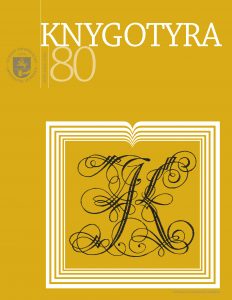 Rusteikaitė, Ieva. Elegant and Practical: Bindings of Books Printed in the Middle of 16th and the First Half of the 17th Centuries in Italy and the Polish–Lithuanian Commonwealth in the Library of Vilnius Jesuit Academy, Knygotyra, Vol. 80 (2023), 228-262. https://doi.org/10.15388/Knygotyra.2023.80.130
Rusteikaitė, Ieva. Elegant and Practical: Bindings of Books Printed in the Middle of 16th and the First Half of the 17th Centuries in Italy and the Polish–Lithuanian Commonwealth in the Library of Vilnius Jesuit Academy, Knygotyra, Vol. 80 (2023), 228-262. https://doi.org/10.15388/Knygotyra.2023.80.130
ABSTRACT
In the early modern period, the relentless growth in the copies of printed books and the increasing competition between craftsmen meant that, since the invention of Gutenberg until the 19th century, European bookbinders were forced to look for cheaper and quicker binding techniques. Based on this assumption, the article focuses on some of the bindings of books printed from the middle of the 16th until the middle of the 17th century which belonged to the library of Vilnius Jesuit Academy. This study is part of a broader research on the bindings of the Vilnius Jesuit Academy Library, and the article is limited to two groups of sources: books printed in Italy and books printed in the Kingdom of Poland and the Grand Duchy of Lithuania (Polish–Lithuanian Commonwealth). The historical bindings are discussed by following the approach targeting the field of decorative arts and material culture studies, which is also well known as the ‘archaeology’ of the book or the bookbinding. It focuses not only on the decorative features of the cover of the book, but also on the structural features of the bindings which reveal comprehensively the work of the craftsmen of the past. This method of analysis is particularly useful for discussing not only decorated but also undecorated bindings which have so far received very limited attention in the research of the old Lithuanian book. As a result, the research revealed that the modest parchment bindings form nearly a half of all the examined bindings of the collection, and confirm the practical rather than the representational aspect of the Jesuit Library. According to the complexity of the technical execution and the number of operations involved in the process of binding, five binding techniques have been distinguished, ranging from the most complex to the simplest bindings, closely related with a retail bindings. What is more, a consistent number of parchment bindings are denoted by structural features, which is close to the Italian bookbinding tradition. The predominance of the latter in the group of Italian prints makes it possible to consider the possibility of already bound books entering the library of Vilnius Jesuit Academy. Moreover, the research has revealed certain binding features linked to the bookbinding traditions in Italy and the Polish–Lithuanian Commonwealth.
The article was based on presentation in the international research conference Francysk Skaryna and the Renaissance Book Culture, that took place in Vilnius, 22-23 September, 2022.
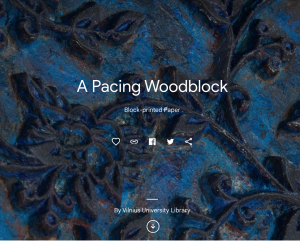 Rusteikaitė, Ieva, Marija Šaboršinaitė and Gediminas Bernotas. Tales of Decorated Paper. Five-part digital exhibition by Vilnius University library via Google Arts & Culture, 2021:
Rusteikaitė, Ieva, Marija Šaboršinaitė and Gediminas Bernotas. Tales of Decorated Paper. Five-part digital exhibition by Vilnius University library via Google Arts & Culture, 2021:
The digital exhibition tells a visual story about history of handmade decorated paper until 19th century. The most popular five techniques are presented through the selected samples preserved in Vilnius University Libraries archives. Richly illustrated tales shows the most common decoration features, but also highlights unexpected and imaginary solutions made by craftsmen of the past.
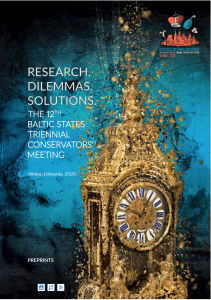 Rusteikaitė, Ieva. Understanding the Craft: an Overview of Conservation of Bindings of Books in the Vilnius University Library in Senvaitienė, Jūratė (ed.) Reseach. Dilemmas. Solutions. The 12th Baltic states Triennial Restorers’ Meeting. Preprints. The Lithuanian National Museum of Art: Vilnius, Lithuania, 2020, 256–268. Online access: http://conservation2020vilnius.ldm.lt/book/.
Rusteikaitė, Ieva. Understanding the Craft: an Overview of Conservation of Bindings of Books in the Vilnius University Library in Senvaitienė, Jūratė (ed.) Reseach. Dilemmas. Solutions. The 12th Baltic states Triennial Restorers’ Meeting. Preprints. The Lithuanian National Museum of Art: Vilnius, Lithuania, 2020, 256–268. Online access: http://conservation2020vilnius.ldm.lt/book/.
ABSTRACT
Paper pretends to look closer to the development of conservation of bindings at the Vilnius University Library as part of the history and professional self-reflexion on conservation of books in Lithuania, scarcely discussed until now. The overview allows to distinguish several different periods in the history of the Department of Restoration: the early years of training new professionals in bookbindery and conservation; a „craftsmen period“ characterized by improvement of skills in bookbindery and collection of tools and teaching of junior conservators; a shift from craft to conservation determined by national conservator‘s certification process, a clearer definition of criteria and methods of intervention and appearance of more systemized professional vocabulary. Finally, a present period which is characterized by re-discovery of the craft, seen from the perspective of a conservator.
The paper is based on the the presentation made in The 12th Baltic States Triennial Conservators’ Meeting Research. Dilemmas. Solutions, held on 29 September–02 October 2021.
Rusteikaitė, Ieva and Sigitas Tamulis. 17th Century Vellum Binding Structures and Their Preservation in Senvaitienė, Jūratė (ed.) Reseach. Dilemmas. Solutions. The 12th Baltic states Triennial Restorers’ meeting. Preprints. The Lithuanian National Museum of Art: Vilnius, Lithuania, 2020, p. 560–562. Online access: http://conservation2020vilnius.ldm.lt/book/
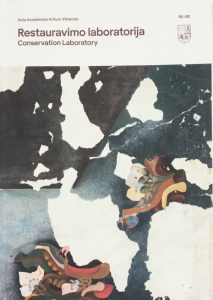 Rusteikaitė, Ieva. Fifty Years of Document Conservation: Archival Material of the Restoration Department of the Vilnius University Library, Acta Academiae Artium Vilnensis, Vol. 92-93 (2019), 450-475. Online access https://leidykla.vda.lt/Files/file/Acta%2092_93/Acta_2019_170x240mm_Rusteikaite.pdf .
Rusteikaitė, Ieva. Fifty Years of Document Conservation: Archival Material of the Restoration Department of the Vilnius University Library, Acta Academiae Artium Vilnensis, Vol. 92-93 (2019), 450-475. Online access https://leidykla.vda.lt/Files/file/Acta%2092_93/Acta_2019_170x240mm_Rusteikaite.pdf .
ABSTRACT
In 1968, the first conservation lab for library materials in Lithuania was established at the Vilnius University Library. This conservation department together with the Graphic Arts Section of the Restoration Centre of the Lithuanian Art Museum that had been founded earlier became the cornerstone of the Lithuanian school of document conservation. The history of the Restoration Department of the Vilnius University Library encourages us not only to celebrate the long-time experience of conservation, but also to apply a critical view. In Lithuania, especially in the environment of social sciences and the humanities, there has been a notable absence of scientific discourse on document conservation and preservation, thus the study of such experience seems relevant and so far unprecedented. The article aims to present the archive of condition and treatment reports covering the period between 1968 and 2017, and to discuss some cases of conservation works carried out over the fifty years.

Rusteikaitė, Ieva. Una galería virtual para redescubrir el universo del papel decorado in Blog de Fons Antic, CRAI Biblioteca de Fons Antic, Universidad de Barcelona, 17 de noviembre de 2016. Online access https://blocbibreserva.ub.edu/2016/11/17/una-galeria-virtual-para-redescubrir-el-universo-del-papel-decorado/ .
A review that invites to explore digital gallery of decorated paper created by Library of University of Barcelona.
